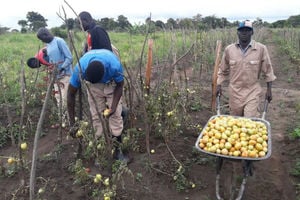
Timothy Njakaasi has discovered dragon fruit as a crop which can withstand climatic changes. PHOTO/GEORGE KATONGOLE
Three years ago, Timothy Njakaasi, an organic farmer in Mukono, faced a health crisis when his daughter developed stomach complications. After seeking medical attention in vain, a herbal doctor in Najeera, a Kampala suburb, advised him to include dragon fruit juice in her treatment routine.
Njakaasi initially struggled to find dragon fruit, as it was scarce and expensive. However, his daughter's recovery motivated him to explore the possibility of growing dragon fruit himself.
"Each dragon fruit, about the size of a fist, cost Shs20,000 in Nakasero Market. I wondered how I could afford to buy them regularly. Despite the high cost, I kept purchasing them until my daughter's health improved," Njakaasi recalls.
Njakaasi, with over a decade of experience as an extension worker, retired in 1997 to pursue organic farming. He established Kasenge Riverford Organic Agricultural Centre in Mbalala, Mukono District, where he has cultivated a variety of crops, including fresh fruits, vegetables, cocoa, vanilla, red pepper, and Hass avocado.
With his background, Njakaasi researched dragon fruit cultivation and discovered that seedlings were available in Kenya. He travelled there to learn from a university lecturer who had experience growing dragon fruit.
Njakaasi started small with an acre of 1,000 seedlings, which he purchased for approximately Shs20,000 each. After about 20 months, his farm began producing dragon fruit. Njakaasi has transferred ownership of the dragon fruit farm to his children as a means of encouraging their involvement in agriculture. He is now focusing on other ventures. His sons, Henry Magembe Ssebowa, a telecom engineering student at UICT, and Emmanuel Solomon Kisaamo, a nurse, have launched a YouTube channel, Mbalala Dragon Fruit Farm, dedicated to sharing their expertise on dragon fruit farming. This initiative has attracted numerous interested farmers to Njakaasi's demonstration garden at Mbalala, where they offer dragon fruit cuttings for sale.
Njakaasi believes that dragon fruit has a bright future in Uganda due to its health benefits and market potential. Njakaasi says that Dragon fruit can be grown as a backyard crop because of its flowers and seedlings. Dragon fruit flowers are a stunning spectacle of nature. These large, nocturnal blooms open only at night to attract pollinators. With their delicate petals and fragrant scent, they are truly a sight to behold. However, their beauty is short-lived, as they bloom for just one night.
"Although dragon fruit may be a relatively new crop in Uganda, its potential for both health benefits and financial gain suggests a promising future," he says.
Farming methods
Initially, Njakaasi used a wider spacing of 9x10 feet, but after experimenting with a denser spacing of 5x6 feet on a demonstration plot, he found the latter to be suitable. He emphasised the importance of providing adequate support to the plants, which encourages vertical growth. Njakaasi recommends planting three cuttings on a single pole to maximise space efficiency.
Planting three cuttings is often recommended because it increases the chances of successful pollination, provides insurance against potential failures, offers a wider variety of fruits and creates a visually appealing arrangement.
He adds that the plant requires training to maintain vertical growth until it reaches at least six feet in height, after which it can expand horizontally.
Pruning is also an essential aspect of dragon fruit cultivation, as it helps maintain plant health, shape, and productivity. The pruned branches are taken into the nursery where they are bred into new cuttings. Each new cutting is sold at Shs20,000.
Market
The global dragon fruit market is projected to witness significant growth, increasing from a value of $507.3m in 2023 to $973.6m by the end of 2033.
The market for dragon fruit is on the rise due to its nutritional value, unique flavour, visual appeal, and growing interest in exotic fruits. Major producers include Vietnam, Taiwan, Thailand, China, among others. The market is expanding to new regions, and there is a growing demand for both fresh and processed dragon fruit products.
With limited harvest, most of the buyers make orders at the farm. Some have even booked flowers for prices ranging between Shs20,000 and 25,000. Njakaasi says that the international recognition of the crop is giving him hope. Njakaasi says he wants to spread the gospel of dragon fruit farming.
“I want to train more people to grow dragon fruit. We shall help them establish farms such that we improve production. We shall also form an association of dragon fruit farmers,” he adds.

Henry Magembe Ssebowa demonstrates how a cutting is made from a dragon fruit. Each cutting costs about Shs20,000.
After boosting production, he hopes to embark on value addition. Dragon fruit offers various value-added opportunities, including processing into juices, purees, frozen fruit, dried fruit, and candied fruit. It can be used in culinary applications like desserts, salads, cocktails, and sauces. Additionally, dragon fruit can be incorporated into health and wellness products, such as dietary supplements, skincare products, and hair care products. Other value-added products include wine, food colourings, and cosmetics.
“The first market is in your community. As an organic farmer, I want to encourage people to mind about their health and consume dragon fruit and its products,” he says.
Challenges
Dragon fruit presents several challenges for farmers. Some dragon fruit varieties require cross-pollination. But Njakaasi says this can be overcome by keeping flowering plants around the farm. Additionally, the plants can be susceptible to pests and diseases, such as mealybugs, scale insects, and fungal infections. Growing dragon fruit is a long-term investment as it can take several years for a plant to mature and start producing fruit. Njakaasi explains that before the fruits fully grow, farmers can try intercropping. At his demonstration farm, the young plants are intercropped with chilli. From his perspective, the biggest challenge so far is termites. He says that termites pose a significant threat by damaging the plants' roots and creating entry points for diseases and pests. It's also costly to obtain supporting materials as the plants grow. With proper care, they can continue to produce fruit for decades. Some reports suggest that they can live up to 50 years or more. "You need support materials for the fruits and those should be able to last many years," he says.
A step-by-step guide
Dragon fruit is gaining popularity worldwide. While it may seem daunting to grow, with the right conditions and care, it's achievable.
While some varieties are self-pollinating, others require cross-pollination. It's advisable to consider planting multiple varieties. The most common dragon fruit varieties include white-fleshed, which is the most popular variety due to its versatility and mild sweetness. It has pink or yellow skin and white flesh with black seeds.
The red-fleshed which is known for its striking appearance and slightly sweeter taste than the white-fleshed variety is also popular. It has deep magenta or red skin and red or purplish flesh.
The yellow variety is a less common variety but is gaining popularity due to its unique colour and refreshing sweetness. It has yellow skin and white flesh. Dragon fruit plants can take several years to start producing fruit, so patience is key.
Dragon fruit thrives in warm climates. They require at least six hours of direct sunlight per day. A well-draining soil rich in organic matter is ideal to prevent waterlogging.
Planting
According to Magembe, breeding dragon fruit cuttings involves propagating new plants from existing ones.
"To begin, select healthy cuttings from a mature plant and prepare them and dip in rooting hormones such as aloe vera, yellow banana or eggs. Plant the cuttings in a well-draining potting mix and provide ideal conditions for root development. Once roots have formed, repot the cutting into a larger pot and care for the new plant as it grows," he says. The most common method of planting dragon fruit is using cuttings. Ensure the cutting is healthy and has several nodes. Plant it in a hole deep enough to support it upright and provide a support structure like a trellis or fence for the plant to climb.
Care and maintenance
Kisaamo says planting dragon fruit on a mound can be a beneficial practice, especially in areas with poor drainage or heavy rainfall. "Mounds can improve drainage, increase soil temperature and promote better root growth," he says.
To plant dragon fruit on a mound, he advises choosing a sunny location to build a mound of soil. The farmer should also add organic matter to the mound to improve fertility and plant the cuttings at the same depth as they were originally growing.
Dragon fruit plants are climbers and require a support structure to grow upright and produce fruit efficiently. Common support structures include trellises, fences, arbors and T-posts.
When choosing a support structure, one should consider the size of the dragon fruit plant and ensure it is sturdy enough to support the plant's weight. Pruning is also essential to maintain the plant's shape and encourage growth along the support structure. On average, a mature dragon fruit plant can produce anywhere from 20 to 50 fruits per year.
Harvesting
Harvesting dragon fruit at the right time is essential for optimal flavour and texture. The fruit should be fully coloured, slightly soft to the touch, and have reached its full size.
Use a sharp knife to carefully cut the fruit from the plant and handle it gently to avoid bruising. Store harvested dragon fruit in the refrigerator for up to a week.
The flavour is often described as a sweet and tangy combination, with subtle hints of citrus. The flesh can vary in colour from white to red or yellow, and the taste can differ slightly depending on the variety. The seeds, while small and edible, have a slightly crunchy texture and a mild, nutty flavour.




